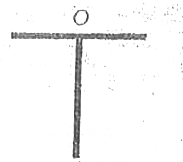Particle of masses m,2m,3m,…,nm grams are placed on the same line at distance l,2l,3l,…..,nlcm from a fixed point. The distance of centre of mass of the particles from the fixed point in centimeters is :
(2n+1)l3
ln+1
n(n2+1)l2
2ln(n2+1)
The correct Answer is:A
To find the distance of the center of mass of the particles from the fixed point, we can follow these steps:
Step 1: Identify the masses and their positions
The masses of the particles are given as m,2m,3m,…,nm grams. The positions of these masses are at distances l,2l,3l,…,nl cm from the fixed point.
Step 2: Write down the formula for the center of mass
The formula for the center of mass xcm of a system of particles is given by:
xcm=∑mixi∑mi
where mi is the mass of the ith particle and xi is its position.
Step 3: Calculate the numerator ∑mixi
Here, we have:
- Masses: m1=m,m2=2m,m3=3m,…,mn=nm
- Positions: x1=l,x2=2l,x3=3l,…,xn=nl
Thus, the numerator becomes:
∑mixi=m⋅l+2m⋅2l+3m⋅3l+…+nm⋅nl
This can be expressed as:
=m(l+4l+9l+…+n2l)
Factoring out l:
=ml(12+22+32+…+n2)
Step 4: Use the formula for the sum of squares
The sum of the squares of the first n natural numbers is given by:
n∑k=1k2=n(n+1)(2n+1)6
Thus, we have:
12+22+32+…+n2=n(n+1)(2n+1)6
Substituting this back into our expression for the numerator:
∑mixi=ml⋅n(n+1)(2n+1)6
Step 5: Calculate the denominator ∑mi
The total mass ∑mi is:
m+2m+3m+…+nm=m(1+2+3+…+n)=m⋅n(n+1)2
Step 6: Substitute into the center of mass formula
Now substituting the numerator and denominator into the center of mass formula:
xcm=ml⋅n(n+1)(2n+1)6m⋅n(n+1)2
Step 7: Simplify the expression
Cancel m and n(n+1):
xcm=l⋅2n+1612=l(2n+1)3
Final Answer
Thus, the distance of the center of mass of the particles from the fixed point is:
l(2n+1)3
The masses of the particles are given as m,2m,3m,…,nm grams. The positions of these masses are at distances l,2l,3l,…,nl cm from the fixed point.
The formula for the center of mass xcm of a system of particles is given by:
Here, we have:
- Masses: m1=m,m2=2m,m3=3m,…,mn=nm
- Positions: x1=l,x2=2l,x3=3l,…,xn=nl
The sum of the squares of the first n natural numbers is given by:
The total mass ∑mi is:
Now substituting the numerator and denominator into the center of mass formula:
Cancel m and n(n+1):
Thus, the distance of the center of mass of the particles from the fixed point is:
Topper's Solved these Questions
- TEST PAPERBOOK - ALLENCHAPTER - TEST PAPEREXERCISE - PHYSICS
4 Videos
- TEST PAPERBOOK - ALLENCHAPTER - TEST PAPEREXERCISE - PHYSICS
4 Videos
- SIMPLE HARMONIC MOTIONBOOK - ALLENCHAPTER - SIMPLE HARMONIC MOTIONEXERCISE - Example
1 Videos
- TEST PAPER 1BOOK - ALLENCHAPTER - TEST PAPER 1EXERCISE - PHYSICS
11 Videos
Similar Questions
The locus of a point at a distance 3 cm from a fixed point.
View SolutionThe locus of points at a distance 2 cm from a fixed line.
View SolutionA particle of mass 100 gm and charge 2μC is released from a distance of 50 cm from a fixed charge of 5μC. Find the speed of the particle when its distance from the fixed charge becomes 3 m.
View SolutionWhen .n. number of particles of masses m, 2m, 3m, …….. nm are at distances x1=1,x2=2,x3=3,……………xn=n units respectively from origin on the x-axis, then find the distance of centre of mass of the system from origin.
View SolutionTwo uniform thin rods each of length L and mass m are joined as shown in the figure. Find the distance of centre of mass the system from point O

View SolutionFour particles having masses, m, 2m, 3m, and 4m are placed at the four corners of a square of edge a. Find the gravitational force acting on a particle of mass m placed at the centre.
View SolutionFour particles having masses, m, 2m, 3m, and 4m are placed at the four corners of a square of edge a. Find the gravitational force acting on a particle of mass m placed at the centre.
View SolutionTwo particles of masses m and 2m are placed at separation L. Find the M.I. about an axis passing through the center of mass and perpendicular to the line joining the point masses.
View SolutionWhen n number of particles of masses m,2m,3m,……..nm are at distances x1=1,x2=4,x3=9,………xn=n2 units respectively from origin on the x-axis, then find the distance of their centre of mass from origin.
View SolutionA particle of mass 2 g and charge 1μC is held at rest on a frictionless surface at a distance of 1m from a fixed charge of 1 mC. If the particle is released it will be repelled. The speed of the particle when it is at distance of 10 m from fixed charge is :
View Solution
